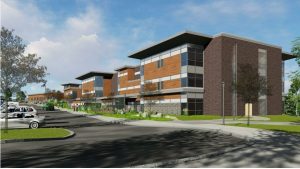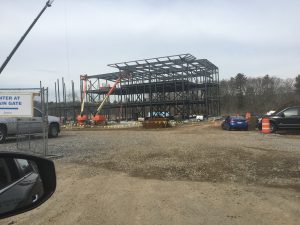When the sun shines on the new Sunita L. Williams school on Central Avenue at its opening in the fall of 2019, it will also be generating electricity to power the school and save money for the community. Solar PV is only one of many exciting features of this new school, but it was one that we weren’t sure would happen.

First, the basics. The proposed system consists of five southern facing groups of panel arrays – 417 panels in all – generating 166.8kW of DC power. That is about 20 times the capacity of a good-sized residential solar system. The system will provide 187,378 kWh of electricity each year, 44.4% of the building’s total electric use. Over its 30-year expected lifespan, the system will save the town almost $900,000 in reduced energy costs.
It’s important to understand how we got here. A municipality builds buildings expected to serve the community for 30 to 50 years. We benefit when we reduce our operating costs and make them as predictable as possible. The Commonwealth of Massachusetts is encouraging the construction of zero net energy buildings to save taxpayer dollars, meet our legal commitments to reduce greenhouse gas emissions and mitigate the impact of climate change.
Green Needham firmly believes that all our construction should incorporate solar and other renewable energy as a base component of the project. But we aren’t there. Energy efficiency and reducing energy use are core considerations for the Permanent Public Building Committee (PPBC) in their oversight of construction projects. New facilities are now almost always solar-ready. But adding solar to a project increases its upfront capital cost. This has meant that solar PV not been a required component in any of our construction projects.
Our hope was that solar could at least be an “add back” to the Williams School project, funded from savings at the end of the project. That would increase the cost somewhat, since the solar would be added after the building was complete. The fact that we can almost always count on some savings is a testament to the outstanding job of the PPBC, our public facilities construction division and our contractors.

For the Williams Project, there was even better news. The bids for the project came back $6 million under the projected and appropriated amount. As a result, the PPBC was able to consider solar PV now. Working with the Town Manager, Superintendent, School Committee, the Select Board and the Finance Committee, a consensus was reached to go ahead with a solar installation, allowing it to be completed during construction.
Beyond the financials and the greenhouse gas reductions, solar at the Sunita L. Williams school has many other benefits. There will of course be many opportunities to incorporate solar into the curriculum.
As an astronaut who set a record by spending a total of 322 days in space, Sunita’s livelihood and her life both depended on solar power. It seems fitting that the next generation of Needham students will be able to depend on solar power – although in a less high-stakes setting.
When the students who attend the Williams School are adults, they will live in a decarbonizing economy. They will thank us for starting down that road for them.

